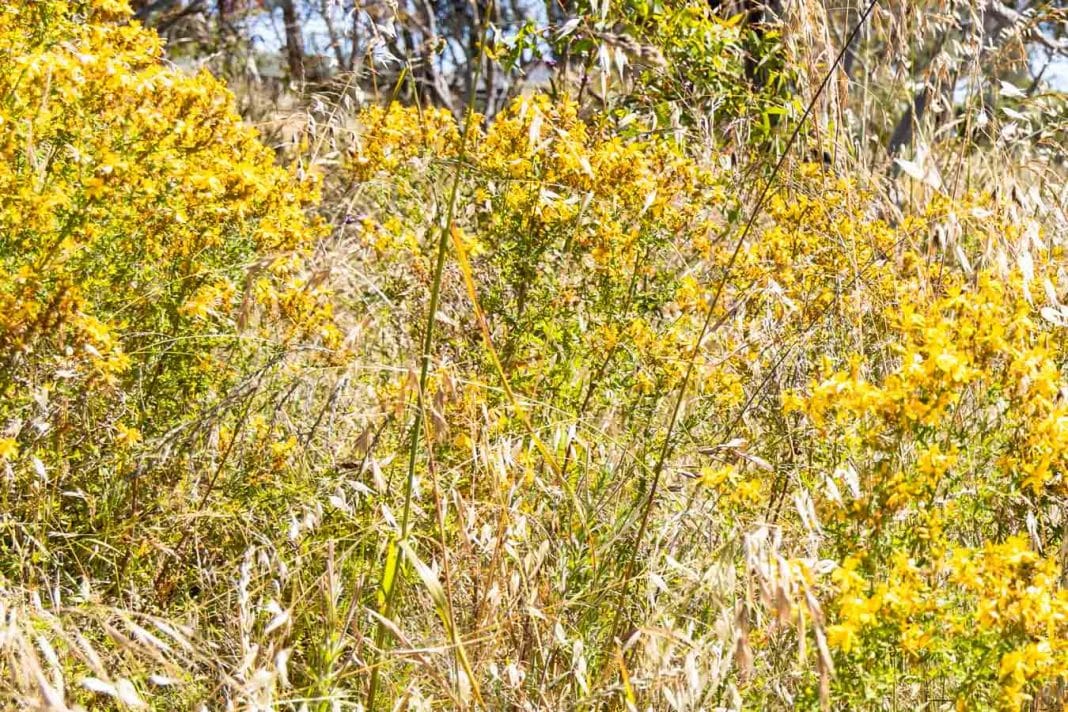St John’s Wort has spread like wildfire across the Canberra region, wreaking havoc on native plant species in grasslands and grassy woodlands – and the invasion is worsening.
Known for its use in alternative therapies, the noxious weed was introduced to Australia from Europe in 1875 to be cultivated for medicinal purposes.
Attempts to contain St John’s Wort to private land failed, and it rapidly reproduced becoming highly invasive.
St John’s Wort is listed as one of the four most serious grassland weeds in the ACT Government’s Natural Temperate Grassland Endangered Ecological Community Action Plan, emphasising the gravity of the environmental threat it poses.
ACT Government says ‘it can’t be eradicated’
Invasive Weeds Officer at the ACT Environment, Planning and Sustainable Development Directorate, Harley Baker, said the weed has been present in Australia for many decades and its numbers have continued to build in certain areas across the region.
Mr Baker said although it doesn’t cause any specific damage to the environment per se, it competes with other surrounding plants for resources.
Additionally, the weed contains a toxic chemical called hypericin that is poisonous to livestock, but many animals won’t graze on it if there are other plants to eat instead, he said.
This year has been quite prolific for the weed, which, according to Mr Baker, “can’t be eradicated”.
“It’s been here for such a long time and [eradicating] it’s not feasible,” he said.
The ACT Government controlled St John’s Wort on 1,300 hectares across the ACT during the last financial year.
Given the sheer number of plants in Canberra’s national parks, the government aims to control and protect sites which have the highest ecological value.
In environments that have a lower ecological value, including degraded roadside areas, St John’s Wort has been left to run wild.
Landcare says weed issue is ‘very serious’
Retired ecologist Rainer Rehwinkel is an active member of Landcare groups and Friends of Grasslands in Canberra and said the weed problem was “very serious”.
Having spent many hours killing and disposing of St John’s Wort, Mr Rehwinkel said the prevalence of the noxious weed over the past few years suggests it will be a major issue in 2023.
“It has the potential to outcompete native plants,” he said.
“It’s unknown if it can be eradicated from the whole [Canberra] region but it’s unlikely.”
As well, the lack of St John’s Wort beetles seen in grasslands and grassy woodlands in the ACT region is “a little bit worrying”.
An option in controlling St John’s Wort, Mr Rehwinkel said the beetles “really knocked it back”.
“If you were to drive to the Victorian border, you would see the weed covering hillsides on western slopes. It’s a major weed this year,” he said.
The weed doesn’t invade areas that are shady, but can create massive infestations where there is plenty of sun, particularly grasslands.
“And really it will be up to the ACT Government to try and work out how to deal with that issue,” Mr Rehwinkel said.
Landcare groups volunteer to physically remove the weed when there’s a “huge invasion,” which “at least reduces the spread throughout the year”, he said.
Removal options in national parks
According to Mr Rehwinkel, when physically removing St John’s Wort without using pesticides or herbicides, it’s important to get ahead of the seeds ripening.
However, he’s not sure of the best solution for disposal, which emphasises the importance of the timing of removal to ensure seeds are not left to sprout.
Placing weeds that have not yet gone to seed in piles in an isolated area is one way to dispose of St John’s Wort.
Carefully spot spraying is a popular technique, ensuring the herbicide does not impact any surrounding native plants.
Get all the latest Canberra news, sport, entertainment, lifestyle, competitions and more delivered straight to your inbox with the Canberra Daily Daily Newsletter. Sign up here.



